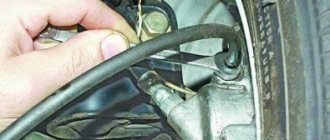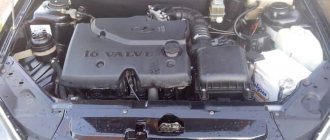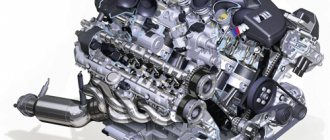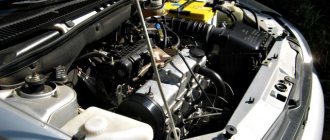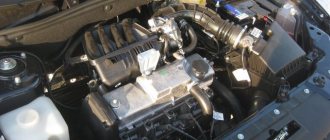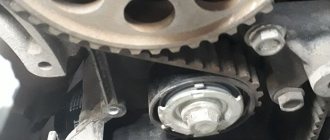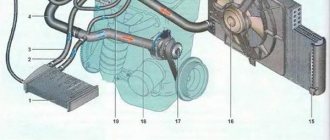Engine VAZ 21126 1.6 l. injection in-line 4-cylinder with overhead camshafts, the gas distribution mechanism is belt driven. The service life of the 21126 Priora engine, according to the manufacturer’s data, is 200 thousand km, how long does the engine run in practice... depending on your luck, on average this is approximately the case.
The car received a lot of unfounded criticism, especially the old 8-valve Priora engine was to blame. However, after the power units for them were replaced with new ones, they simply amazed car enthusiasts. If you look at the technical specifications, it is almost impossible to see much of a difference. But consumption decreased by 1 liter, power increased. The engine began to run much quieter than its ancestor. This is felt by both the driver and passengers. Just look at the photo of the engine to understand everything.
Engine characteristics Priora 1.6 16 valves
• Years of production – (2007 – today) • Cylinder block material – cast iron • Power system – injector • Type – in-line • Number of cylinders – 4 • Valves per cylinder – 4 • Piston stroke – 75.6mm • Cylinder diameter – 82mm • Power compression – 11 • Priora engine volume – 1597 cm3. • Engine power of the Lada Priora is 98 hp. /5600 rpm • Torque – 145 Nm/4000 rpm • Fuel – AI95 • Fuel consumption – city 9.8 l. | track 5.4 l. | mixed 7.2 l/100 km • Oil consumption in the Priora engine is 50 g/1000 km • The weight of the Priora engine is 115 kg • Engine oil for Lada Priora 21126: 5W-30 5W-40 10W-40 15W40 • How much oil is in the Priora engine : 3.5l. • When digging, pour 3-3.2 liters. Priora engine life:
1. According to the factory – 200 thousand km 2. In practice – 200 thousand km
TUNING
• Potential – 400+ hp
• Without loss of resource – up to 120 hp. The engine was installed on:
• Lada Priora • Lada Kalina • Lada Granta • Lada Kalina 2 • VAZ 2114 Super Auto (211440-26)
What cars was it in?
Immediately after its release, AvtoVAZ management began using the 21126 engine to power the following Lada models:
- Priora - from 2007 to 2016, all trim levels;
- Kalina - from 2007 to 2013, Luxury equipment;
- Kalina-2 - since 2013, on cars with automatic transmission;
- Granta - since 2011, Norma and Luxury equipment.
Lada Granta
Currently, Priora engines are equipped with 21127 engines, which have become the next version of the development of the 21126 internal combustion engine. On the other two models - Kalina-2 and Granta, this engine is used mainly with the JF414 automatic transmission from the Japanese manufacturer Jatco.
Malfunctions and repairs of the Priora 21126 engine
The 21126 engine is a continuation of the VAZ 21124 ten-wheel drive engine, but with a 39% lighter ShPG produced by Federal Mogul, the holes for the valves have become smaller, and a different timing belt with an automatic tensioner, thanks to which the problem of tightening the belt on the 124 block has been solved. The Priora engine block itself has also undergone minor changes, such as better surface treatment, and cylinder honing is now carried out in accordance with the more stringent requirements of Federal Mogul. On the same block above the clutch housing there is a place with the Priora engine number; to see it, you need to remove the air filter and arm yourself with a small mirror.
There is a lightweight version of this engine - the Kalina engine 1.4 VAZ 11194, as well as a sports forced version - the VAZ-21126-77 engine (120 hp). This is the result of modification of the VAZ-21126 engine. A distinctive feature of the motor is its power, which increases after 3000 rpm. Otherwise the engines are almost identical. When the timing belt breaks, the valve also bends. Among the disadvantages of this power unit, it is worth noting unstable operation, loss of power, timing belt. The reasons for unstable operation and refusal to start may be problems with fuel pressure, timing malfunction, faulty sensors, air leaks through hoses, or a malfunction of the throttle valve. Loss of power may be due to low compression in the cylinders due to a burnt-out gasket, wear of the cylinders, piston rings, or burnt-out pistons. A significant drawback is that the Priora 21126 engine bends the valves. The solution to the problem is to replace the pistons with plugless ones. However, the Priora engine is currently one of the most advanced domestic engines, perhaps the reliability is worse than that of the 124th, but the engine is also very good and powerful enough for comfortable movement in the city. In 2013, a modernized version of this engine was released, marking the new Priora engine VAZ 21127. In 2015, production began of the NFR sports engine called 21126-81, which used the 21126 base. And since 2016, cars with 1.8 liter engines 21179, which was also used, have been available 126th block.
Why are tags needed?
The operation of a four-stroke internal combustion engine occurs in a strictly defined order of movement of the pistons, opening and closing of valves. If this order is violated, the engine will not work, and in some cases it may fail. In the process of fine-tuning the power unit, the manufacturer selected the optimal phases for opening and closing the valves. At the right moment they are activated by the camshaft cams. To correctly set the valve timing when assembling the engine or replacing the timing belt, marks are provided.
Lada Priora timing diagram
| Temperature at which the main thermostat valve begins to open, °C | 83-87 |
| Full opening temperature of the main thermostat valve, °C | 102 |
| Opening pressure of the outlet valve of the expansion tank plug, kPa (bar) | 110-150 (1,1-1,5) |
| Opening pressure of the inlet valve of the expansion tank plug, kPa (bar) | 3-13 (0,1) |
| Coolant temperature in a warm engine at an ambient temperature of 20–30 °C and a fully loaded vehicle moving at a constant speed of 80 km/h, no more, °C | 95 |
| Volume of liquid in the engine cooling system, l | 7,84 |
| Coolant (mixing liquids of different brands is not allowed) | Lada-A40; OZH-K Tosol-TS; OZh-40 Tosol-TS; OZh-65 Tosol-TS; Antifreeze G-48; Cool Stream Standard; Cool Steam Premium |
Expansion tank. Coolant is poured into the system through the expansion tank. It is made of translucent plastic, which allows you to visually monitor the liquid level. To do this, the marks “MAX” and “MIN” are marked on the wall of the tank. In the upper part of the tank there are two pipes for connecting the steam removal hoses of the radiator of the cooling system and the heater, in the lower part there is a pipe for connecting the inlet hose of the cooling system.
Coolant pump (pump) - circulates coolant. It is bladed, centrifugal type, driven from the crankshaft pulley by a timing belt. It consists of a housing, a bearing assembly with a seal, an impeller and a toothed pulley. There is a control hole in the pump housing to detect fluid leakage when the pump seal fails. The pump should be replaced as an assembly.
Jamming of the pump pulley due to failure of its bearing assembly or due to freezing of highly diluted coolant will lead to breakage of the timing belt and, as a result, to expensive engine repairs.
Thermostat. Two thermostat valves - main and bypass - redistribute fluid flows in the cooling system. You will find the thermostat opening and closing temperatures below.
The radiator consists of two vertical plastic tanks (the left one with a baffle) and two horizontal rows of round aluminum tubes passing through the cooling plates. The bases of the tubes are connected to the tanks through rubber gaskets. The liquid is supplied through the upper pipe and discharged through the lower. Above the inlet pipe there is a thin pipe for the steam removal hose. There is a drain plug at the bottom of the right tank. A plastic casing with an electric fan is attached to the radiator.
The heater radiator is built into the engine cooling system and is designed to heat the passenger compartment by circulating hot coolant through it.
The fan maintains the thermal operating mode of the engine and is switched on via a relay based on a signal from the engine control system controller. To monitor the coolant temperature, a temperature gauge sensor is screwed into the engine cylinder head in the instrument cluster.
The cooling temperature sensor reads temperature data and transmits it to the electronic control unit, which adjusts the temperature. It is installed on the thermostat. A faulty element may cause the motor to overheat because the electric fan will not turn on.
The cooling water jacket is located inside the cylinder block and cylinder head. It ensures the removal of heat from these elements, which heat up during operation. So, with the help of a water pump and pipes, the liquid moves into the radiator, where cooling actually occurs, and then returns to absorb new heat.
If you find an error, please select a piece of text and press Ctrl+Enter.
The most basic malfunctions of the 126 engine
Let's move on to the malfunctions and shortcomings, what to do if the Priora engine is running rough, sometimes flushing the injectors solves the problem, it may be the spark plugs or the ignition coil, but the usual thing in this case is to measure the compression in order to eliminate the problem of valve burnout. But the cheapest option is to go to a service center for diagnostics.
Another common problem is when the engine speed of the Priora 21126 fluctuates and the engine runs unevenly, a common disease of VAZ sixteen valves, your mass air flow sensor is dead! Not dead? Then clean the throttle valve, there is a possibility that the TPS (throttle position sensor) needs to be replaced, perhaps the IAC (idle air regulator) has arrived. What to do if the car does not warm up to operating temperature, perhaps there is a problem with the thermostat or the frost is too severe, then you will have to put cardboard on the radiator grill. Regarding overheating and warming up, is it necessary to warm up the engine? Answer: it definitely won’t get worse, warm it up for 2-3 minutes and everything will be fine. Let's return to the jambs and problems of engines, your Priora engine does not start, the problem may be in the battery, starter, ignition coil, spark plugs, fuel pump, fuel filter or fuel pressure regulator. The next problem is that the Priora engine is noisy and knocking, this occurs on all Lada engines. The problem is in the hydraulic compensators; the connecting rod and main bearings can knock (this is already serious) or the pistons themselves. You feel vibration in the Priora engine, the problem is in the high-voltage wires or in the IAC, perhaps the injectors are dirty.
Why are hydraulic compensators knocking?
The 21126 engine is a reliable design with a long service life, but even with such characteristics, difficulties may arise in the operation of the gas distribution mechanism. Over time, when driving a Priora, a characteristic knocking sound of the hydraulic compensators occurs when cold or hot. In this case, there is a drop in the power of the power unit and an increase in the noise level of the latter.
It is worth noting that the service life of this part for VAZ 2170-72 Priora cars is about 100 thousand kilometers. It may vary and depends on the quality of the oil used.
The main reason why knocking occurs is the characteristics and quality of the engine oil. The design of hydraulic compensators implies increased sensitivity to the characteristics of the lubricant and, accordingly, deviations from the manufacturer’s recommendations directly affect the service life of the hydraulic fluid.
Video on the topic:
» Quite often the knocking problem is solved by changing the engine oil. In this case, it is necessary to flush the engine with a special liquid.
Almost always, after an oil change, a characteristic noise from the compensators follows, because the new oil has not had time to rise to the plunger pair of the hydraulic valve. This is observed for about the first five minutes of engine operation, after which the knocking stops.
If after changing the oil the situation has not changed and the knocking continues, then there is the option of flushing the power unit, which is done in two ways:
- Use of special flushing fluid. It is poured into the engine and temporarily used in it. However, its effect is questionable, since there are often fakes on the market, and they do not help.
- Dismantling and manual washing of each hydraulic compensator.
Engine tuning Priora 21126 1.6 16V
Chip tuning of the Priora engine
As a pampering activity, you can play with the sports firmware, but there will be no obvious improvement; see how to properly increase the power below.
Priora engine tuning for the city
There are legends that the Priora’s engine produces 105, 110 and even 120 hp, and the power was underestimated to reduce taxes, various measurements were even taken in which the car produced similar power... what everyone decides to believe, let’s focus on the indicators declared by the manufacturer. So, how to increase the power of a Priora engine, how to charge it without resorting to anything special, for a small increase you need to let the engine breathe freely. We install a receiver, a 4-2-1 exhaust, a 54-56 mm throttle body, and we get about 120 hp, which is quite good for the city.
Boosting the Priora engine will not be complete without sports camshafts, for example, STI-3 camshafts with the configuration described above will provide about 140 hp. and it will be fast, an excellent city motor. The refinement of the Priora engine goes further, sawn cylinder head, Stolnikov 9.15 316 shafts, light valves, 440cc injectors and your car easily produces more than 150-160 hp.
Operating principle of hydraulic compensators
The main purpose of using HA in the Priora engine is to simplify the engine maintenance procedure. If previously it was necessary to adjust each valve separately, now this procedure is carried out automatically.
Structurally, the hydraulic compensator is a cylindrical part, which consists of a plunger pair located inside its body, as well as a check valve.
The operating principle of this mechanism is simple. During operation of the power unit, the camshaft cam presses the bottom of the cylinder. In this case, the hydraulic compensator moves, as a result of which the plunger presses on the valve and, accordingly, it opens.
The clearance mentioned above is regulated by the oil pressure entering the cavity under the plunger. The greater the oil pressure, the stronger it acts on the plunger and, accordingly, the valve opens with a larger gap.
Compressor for Priora
An alternative method of obtaining such power is to install a compressor, for example, the most popular option is an Auto Turbo kit based on PK-23-1, this compressor is easily installed on a 16-valve Priora engine, but with a lower compression ratio. Then there are 3 options: 1
.
The most popular is to lower the coolant gasket with a gasket from a twelve-wheeler, install this compressor, exhaust on 51 pipes, Bosch 107 injectors, install it and go to the track to watch the car go downhill. But the car doesn’t run very well... then running to sell the compressor, writing that the Autoturbo doesn’t work and all that... is not our option. 2
.
We lower the coolant by installing a thick cylinder head gasket from 2112, for a St. Petersburg supercharger at a pressure of 0.5 bar this will be enough, we select the optimal narrow-phase shafts (Nuzhdin 8.8 or similar), exhaust 51 pipes, Volga BOSCH 107 injectors, a receiver and a standard throttle body. To fully push the configuration, we give the cylinder head to cut the channels, install larger lightweight valves, this is not expensive and will provide additional power throughout the entire range. This whole thing needs to be configured online! We’ll get an excellent motor with a power of more than 150-160 hp that can perform in any (!) range. 3
. We lower the coolant by replacing the piston with a tuning one for the turbo, you can put a proven Nivov piston with a puddle under the turbo on 2110 connecting rods, on such a config you can put a more efficient compressor, a Mercedes one for example, blowing 1-1.5 bar with a power well over 200+ hp . and act like the devil! ) The advantage of the config is the ability to install a turbine on it in the future and blow out at least all 300+ hp. if the piston doesn't go to hell))
Basics of the design and operation of a hydraulic compensator
Configuration
The idea of automatic regulation of thermal clearances can be implemented in two versions: a conventional hydraulic pusher and a hydraulic support.
The latter is used in gas distribution modules with rocker arms. On the Lada Priora in the sixteen-valve version, the intake and exhaust are equipped with individual camshafts. The optimal solution for this arrangement is the use of a hydraulic pusher. The Priorov hydraulic compensator on the 126 engine consists of the following parts:
- A plunger pair, including a cylindrical cage and a piston with a ball valve.
- The outer housing is a pusher.
- System of grooves and holes for oil supply.
Principle of operation
The oil composition enters the internal cavity of the piston and, overcoming the resistance of the spring, pushes the ball away to fill the closed cylinder. When filling the liner, oil pushes the piston out and the hydraulic tappet rests against the cam. Next, the ball valve is locked and the assembly unit works like a regular pusher on motors with an adjustable valve mechanism.
Boring the Priora engine or how to increase the volume
Let's start with how you don't need to increase the volume, an example would be the famous VAZ 21128 engine, don't do that)). One of the easiest options to increase volume is to install a motorcycle kit, for example STI, we choose it for our 197.1 mm block, but do not forget about the jambs of the 128 engine, do not rush to install a long-stroke elbow. You can go the other way and purchase a high block 199.5 mm Priora, 80 mm crankshaft, bore the cylinders to 84 mm and a connecting rod 135.1 mm pin 19 mm, this will give a total of 1.8 volume and without damage to R/S, the engine can be twist freely, install evil shafts and squeeze out more power than a regular 1.6l. To spin your engine even more, you can build up a standard block with a plate, how to do it, how it spins on a 4-throttle intake and wide shafts.
Why is adjustment necessary?
The correct procedure depends on:
- uninterrupted operation of the LADA Kalina engine (operation with a reduced noise level in the timing belt, no errors in the camshaft sensor);
- reduction of fuel consumption to a level close to that regulated by the manufacturer;
- less wear on the camshaft cams and the pushers interacting with them.
- cleanliness of combustion chambers and valve plates due to the absence of carbon deposits.
Valve adjustment in a Lada Kalina car should be carried out with a periodic mileage of 20 thousand km or a little more.
It is not recommended to neglect this procedure, since the regulatory value of the gaps at the valves of the intake and exhaust circuits changes. This circumstance provokes a loose fit of the valve discs to the seat seats, which inevitably leads to the formation of carbon deposits, incomplete combustion of fuel, damage to the discs with subsequent burnout and other troubles in the timing belt in the LADA Kalina model. As you can see, in the absence of the required clearances, there is a violation of the correct functioning of the engine as a whole, and the only harmless point here is the owner’s acoustic discomfort due to the increased noise of the timing belt.
Note that adjustment of the valve mechanism requires 8 valve engines of Lada Kalina cars.
Priora on throttles
To increase the stability of the engine and the response of the gas pedal, 4 throttle bodies are installed on the intake. The bottom line is that each cylinder receives its own throttle valve and, thanks to this, resonant air vibrations between the cylinders disappear. We have more stable engine operation from bottom to top. The most popular method is to install a 4-throttle intake from Toyota Levin on a VAZ. You need to purchase: the unit itself, make an adapter manifold and pipes, in addition to this you need a nulevik filter, Bosch 360cc injectors, DBP (absolute pressure sensor), fuel pressure regulator, wide shafts (phase over 300), sawing cylinder head channels 40/35, light valves, Opel springs, rigid pushers, spider exhaust 4-2-1 on 51 pipes, or better yet, on 63 pipes. There are ready-made 4-throttle intake kits on sale that are quite suitable for use. With the correct prior configuration, the engine produces about 180-200 hp. and more. To go beyond 200 hp. on a VAZ atmosphere, you need to take shafts like STI Sport 8 and spin them at 10,000 rpm, your engine will produce more than 220-230 hp. and this will be a completely hellish drag cramp. The disadvantages of chokes include a reduction in engine life and this is not surprising, because even city engines on pipes spin at more than 8000-9000 rpm or more, so you cannot avoid constant breakdowns and repairs of the 21126 Priora engine.
Location of valves in a VAZ 2110, 2111, 2112 car
Using the above diagram, we will look at the structure of engines and the arrangement of valves in the VAZ 2110, 2111 and 2112 (with an injector and carburetor) for 8 valves.
3 – pusher; 4 – surface of the bearing housing;
5 – shaft for distribution; 6 – washer for regulating fuel supply;
7 – oil reflecting cap; A - gap between the mechanism cam and the adjusting washer.
In this diagram we will look at the structure of VAZ 2110, 2111 and 2112 engines with 16 valves. The 16-valve engine version uses a DOHC-type twin-shaft timing belt as shown in the picture below.
Next you can see a side section of the engine. As you can see, the 16-valve engine uses two camshafts, but otherwise the system is not much different from the 8-valve version.
And now a little about the innovation in the VAZ 2112, where an injector is used instead of a carburetor. Gasoline engines have either a fuel injector or are equipped with a carburetor. These two units perform the same function - they form a combustible mixture for supply to the engine. But how are they different? Differences between a carburetor and an injector:
- In the carburetor, the combustible mixture is sucked into the engine, and in the injector it enters the engine cylinders through injection.
- The carburetor is unstable, while the injector ensures efficient engine operation.
- The operation of the injector does not depend on weather conditions. The carburetor freezes in severe frosts.
- An injection engine picks up speed easier than a carburetor engine.
- The injector is more picky about fuel quality.
Air conditioning systems
One of the consumers is a heating device. It is part of the climate control system. A control controller works with this system. The work is automatic. The driver only sets certain parameters.
On cars, the electrical circuit of a VAZ Priora may contain air conditioning systems. After pressing the button, the relay is activated, the compressor is turned on, power is supplied to the electromagnetic clutch, and the pump is turned on. The air conditioning turbocharger begins to rotate, creating pressure, and begins to regulate refrigerant through the system.
Problems when paying with bank cards
Sometimes difficulties may arise when paying with Visa/MasterCard bank cards. The most common of them:
- There is a restriction on the card for paying for online purchases
- A plastic card is not intended for making payments online.
- The plastic card is not activated for making payments online.
- There are not enough funds on the plastic card.
In order to solve these problems, you need to call or write to the technical support of the bank where you are served. Bank specialists will help you resolve them and make payments.
That's basically it. The entire process of paying for a book in PDF format on car repair on our website takes 1-2 minutes.
If you still have any questions, you can ask them using the feedback form, or write us an email at
Action of auxiliary elements
The list of equipment included in the auxiliary electrical circuit of the VAZ is wider than that discussed above. This:
- light and sound elements, lamps, signal, etc.;
- glass cleaning and washing system;
- interior ventilation unit;
- engine cooling fan;
- rear window heating unit;
- dashboard;
- electric booster;
- electric mirror drives;
- anti-theft system.
For the Priora Lux model, air conditioning, fog lights, light and rain sensors, and several meters of additional wiring will also be added. Before starting, this entire list of equipment will be powered by a battery; after starting, the Priora’s electrical circuit begins to be powered by a generator. When the load is high, some equipment can be switched to battery power for some time. Control over the operation of all wiring and devices is carried out using a set of special sensors.
Electrical diagram of the dashboard (dashboard) of the VAZ-2170 Priora
Part of the on-board network is designed to power the main group of vehicle equipment. The control and display elements of the instrument panel are concentrated here. The wiring supplies power to loaded parts and critical components:
- 1-3 – contact group of the front harness;
- 4 – supply voltage to the aft connector;
- 5 – power supply from the fuse panel;
- 6 – contact group of stops;
- 7 – instrument panel indication;
- 8 – control of illuminators;
- 9 – contact group of emergency airbags;
- 10 – horn;
- 11 – power supply of the diagnostic unit;
- 12 – on-board PC control;
- 13 – ignition coil controller;
- 14 and 15 – supply voltage to the EUR control unit;
- 16 – control of power window equipment;
- 17 – alarm relay;
- 18 – wiper regulator;
- 19 – air flow distributor for the ventilation system;
- 20 – stove;
- 21 – heater drive;
- 22 – heated rear wind window;
- 23 – onboard clock;
- 24-25 – radio connection;
- 26 – emergency warning button;
- 27 – glove compartment lighting;
- 28 – control button for the glove box illumination;
- 29 – bundle of wiring for ignition;
- 30 – to the emergency airbag control board.


